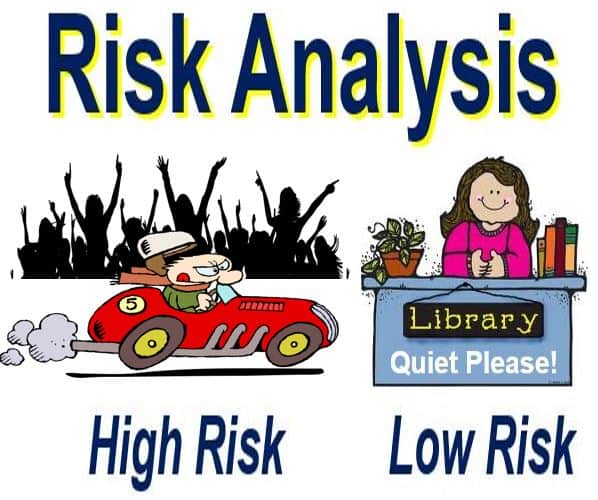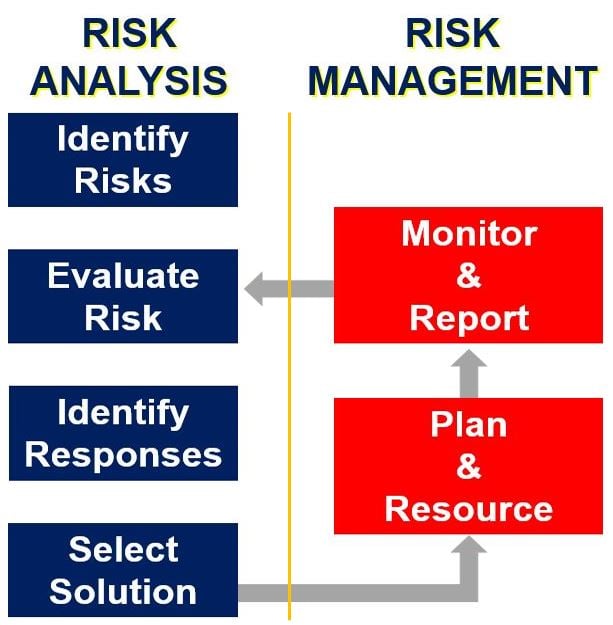Risk analysis is the process of analyzing, determining, and defining the risk of danger to government agencies, and businesses. We also use it to determine risk to individuals, towns, cities, and whole national economies.
Specifically, the analysis looks at potential natural and anthropogenic events. Anthropogenic events are events that human activity causes.
In IT, we commonly use a risk analysis report to align technological goals with those of the company. IT stands for information technology. Risk analysis is both quantitative or qualitative.

We can all determine that a racing driver’s life is riskier than a librarian’s. However, calculating how much their monthly/annual insurance premiums should be is not so easy. Insurance underwriters carry out comprehensive risk analyses. They determine whether to provide cover and if so, at what rate.
Risk consists of two parts:
- The chances of something unpleasant happening.
- The consequences – negative ones – if it does.
Risk analysis involves studying the underlying probability of a given course of action actually taking place.
In finance, it refers to the uncertainty of future cash flow streams we have predicted. It also refers to the variance of stock or portfolio returns and potential future economic circumstances.
All large businesses need a minimum sort of risk analysis. For example, large retailers need to factor in the possibility of declining revenues due to rising unemployment.
Financial institutions, on the other hand, must adequately hedge against the foreign exchange exposure of overseas loans.
In most countries, regulators require that their banks identify and quantify their risks. They must make sure they have enough capital to withstand shocks.
 Risk management follows risk analysis.
Risk management follows risk analysis.
To prepare yourself for a possible adverse event, you first need to determine how likely it is.
Being ready for adverse events
Risk analysis is less about avoiding adverse events completely, and more about being able to cope and survive. In other words, being ready for them if they happen.
It is a process that helps us identify and manage potential adverse events that could undermine key projects or business initiatives.
When carrying out a risk analysis, we need first to identify what the possible threats are and estimate their chances of happening. We must also determine how much it would cost to get back on track.
When do we use risk analysis?
– If we are planning a project (or more than one). It helps us anticipate and neutralize possible adverse events.
– When we are planning for changes in our environment, such as government legislation or the emergence of new competitors.
– To prepare for adverse events, such as theft, fire, employee sickness, technology failure, or natural disasters.
– When we are deciding whether to approve or abandon a project.
Risk analysis: Threats and risks
When we carry out a risk analysis, we must follow two steps: Identify Threats and Estimate Risk.
Identify Threats
We first have to identify the existing and possible future threats that we might face, such as:
- Financial: examples include steep fluctuations in stock market prices, a sudden change in interest rates. An unexpected withdrawal of funding is also a financial threat.
- Human: these may come in the form of injury, death, illness, or the loss of key personnel.
- Natural: earthquake, volcanic eruption, hurricane, flood, or a disease (pandemic or epidemic).
- Operational: such as loss of access to a vital raw material or distribution problems. If a shipping rout suddenly closes, it could mean the kiss of death for some companies.
- Reputational: an unfortunate incident may damage the company’s brand name. There may be loss of employee or customer confidence.
- Structural: any situation where staff, customers, or visitors suffer an injury due to dangerous chemicals, inadequate lighting, etc.
- Technical: a virus or malware damages the company’s IT system, advances in technology or or a global crisis. A widespread and long-term shutdown of the Internet is an example of a global crisis. For company’s like Amazon.com, no Internet would mean absolutely no business at all.
Estimate Risk
After identifying which threats potential threats, you must then estimate how likely they are. You must also estimate what their possible impact might be.
After estimating what the likelihood of a particular adverse event is, you then have to multiply that by how much you think it would cost to set things right if it did occur. You would then have a value for the risk:
Risk Value = Probability of Adverse Event x Cost of Event
For example, imagine you have a business is in the UK. A raw material that you must import represents half the cost of your finished product.
You know there is a risk that your currency may decline significantly. This would subsequently make the import more expensive for you.
You believe there is an 80% probability that your currency will devalue sharply within the next 12 months. You believe this because of global trade news indicating volatility.
Therefore, the risk value of the increased cost of raw material is:
0.80 (likelihood of Event) x £2,000,000 (Cost of Event) = £1,600,000 (Risk Value).
Risk analysis – computer simulations
We could create real-life situations to determine what the risk of an adverse event is The situations could also determine what its impact might be.
However, real-life situations are too dangerous. Therefore, we resort to computer simulations, i.e., risk models.
With some sophisticated computer models, the business is put through near real-life simulations. The aim is to determine how it would cope, just like engineers do with model airplanes in wind tunnels.
These experiments pose no risk for the company. However, they give us vital data on what might unfold if something unpleasant happened.
With state-of-the-art computers and software, we can get fairly accurate risk analyses (plural of analysis is analyses). Computers allow us to perform several trials over a short time at very low cost.
Insurance companies use simulation software all the time to help determine how much they should charge their customers.
Risk analysis vs. risk management
Risk analysis looks at the probability of something happening and what the impact might be. On the other hand, risk management is all about managing that risk.
To determine how to manage a risk, first we need to analyze or assess it.
Risk management involves integrating the insights gained from a risk assessment with strategic decisions on how to address that risk, taking into account both technical and social factors.
In contrast, risk assessments are primarily conducted to provide the information and insights needed to guide those decisions
Put simply; risk analysis defines the risk while risk management determines what to do about it.
Qualitative Vs. Quantitative Risk Analysis
Qualitative risk analysis prioritizes the project risks using a pre-defined rating scale.
With Qualitative risk analysis, we give each risk a score according to their probability.
Quantitative risk analysis, on the other hand, is a further level of risk analysis of the highest priority threats. We usually assign a numerical value e.g. cost of risk to the business and / or project tasks.
Joint Probability
When determining risk, statisticians gather large quantities of numbers and analyze them.
Statisticians may calculate the risk of one event occurring or two occurring at the same time. When they are determining the likelihood of two or more events happening simultaneously, they are calculating joint probability.
